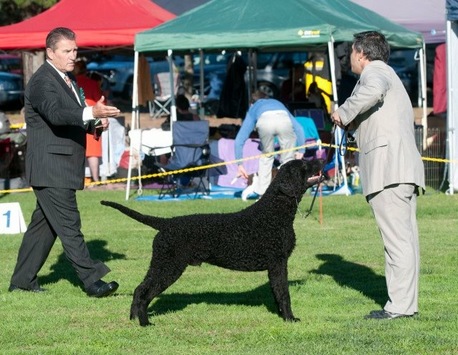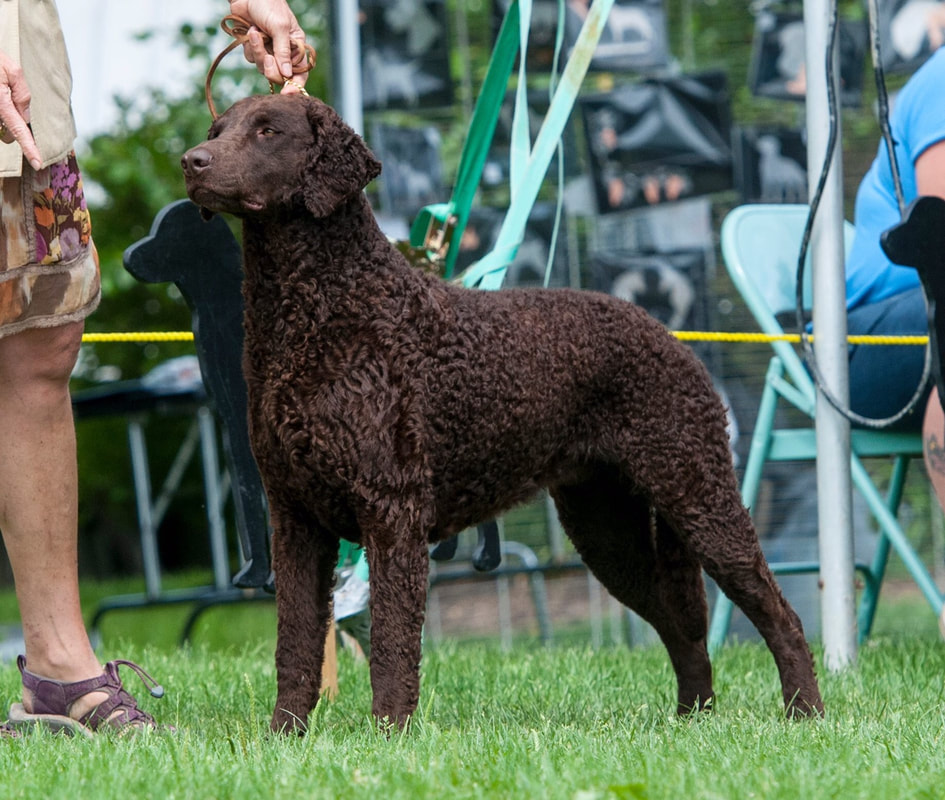|
In the photo above, Lauradale Solar Eclipse, a great example of a Curly Coated Retriever whose blood lines bring many new ancestors, with much genetic diversity, to my Curlies. Owned by Viki Knowles in Australia and bred by Ms. G E Greer.
In the photo below, Ch. 4eyesonly Askari, JH, my foundation bitch from Germany, who is also a great example of everything a Curly Coated retriever should be. |
Tephra Curly Coated Retriever Philosophy
My primary aim at Tephra Curly Coated Retrievers is to breed dogs who are healthy and have good temperaments. After that, working ability, soundness of structure and coat quality are very important.
I strictly follow the AKC health clearances for breeding (OFA hips, elbows, eyes and heart) Although recently, I have moved toward PennHip clearances, which are more costly, but are considered a more accurate predictor of hip quality. I also test for a few of the genetic diseases that can affect retrievers (MyDog DNA) However, I do not use the current Labrador Retriever EIC test as this test is not accurate in Curly Coated Retrievers, probably because Curly Coated Retrievers are more genetically related to the Irish Water Spaniel, American Water Spaniel and Newfoundland than to the Labrador Retriever. But these are just a few of the diseases that can affect dogs. We do not have a test for every disease a dog can get. So, in order to lower the probability of other diseases, I spend a great deal of effort bringing in new blood to my lines that has not been used before. Genetic diversity is critical for immune and reproductive health. Increasing genetic diversity is nature's way of preventing the expression of recessive genes that can cause disease. Breeding
Inbreeding (incest) is taboo throughout systems in nature. Wild animals actively avoid inbreeding. I respect the laws of mother nature and do not support inbreeding or intentional line breeding. This means I keep track of the Unique Ancestor Coefficient and the Coefficient of Inbreeding for every dog I own. A breeding is done only if the 4 generation Unique Ancestor Coefficient is above 95%. This can be quite a challenge in our small breed, but it is, in my opinion, the most important thing I can do to provide puppy owners with healthy dogs.
|
Nutrition and environment |
My dogs are fed N&D Farmina and raw foods. Bones, fresh meat, eggs and seafood are a staple at my house. This results in puppies that grow with straight bones and reduced risk for joint problems, allergies, and skin conditions. My brood bitch is kept free from flea and tick medications and other herbicides and pesticides during pregnancy and whelping. Puppies are also provided with a chemical free environment in which to grow. As much as possible, puppies are raised outside where they can run and play in a natural way to develop agility and where they can acquire vitamin D to encourage good joint health.
|
Temperament and socialization |
The number one reason dogs are not successful in homes is due to temperament problems. Temperament is influenced by genetics, but also strongly influenced by early socialization. Every effort is made to provide the pups with early socialization including exposure to new places, new things, new people and new dogs. Pups are also exposed to many different outdoor environments including water. Finally, pups are carefully placed in homes that match their needs and skills. Compatibility is also important for success.
|
Animal welfare |
I support the Humane Society of the United States, the Animal Welfare Act and the Puppy Protection Act 1624. I strongly encourage puppy buyers to follow these general guidelines when buying a purebred puppy: 1) always meet the mother of the puppy and insist on seeing the location where the puppy is born and raised (NEVER MEET A BREEDER AT ANOTHER MORE CONVENIENT LOCATION) 2) request vet and health records (OFA hip report, heart report and eye report) of the dam and sire. Never buy a puppy where the breeder does not comply with these two points. Instead report the breeder to the AKC and/or the State Dept of Agriculture.
|

